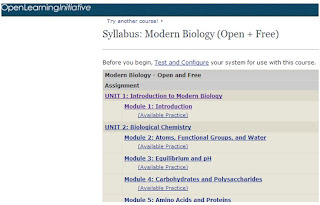Distance
education provides a flexible learning environment for students to learn despite
the fact that the student and instructor are separated by time and/or distance.
The delivery method for instructional content determines the strategies and
tools used in an instructional design. Traditional classrooms require different
learning strategies than those used in an online learning environment. One
major tool in the implementation of online instructional design is a course
management system (CMS) or learning management system (LMS). This is an online
environment that allows an instructor to bring all of the elements of a course
into one central, organized location. Given the large variety of course and
learning management systems, it is essential to research the options to
determine which will be appropriate for a particular instructional design or
training project.
In
the video webcast, Dr. Siemens (Laureate Education, Inc, 2010) points out that
as new technology tools become more useful in a distance learning environment; online
learning will become more effective as a learning strategy. Tools such as concept
mapping software, instant messaging, presentation software, media software, and
discussion/collaboration technology are becoming more advanced and prevalent
which helps to improve the quality of distance education. These learning tools
will help to create a learning community, distinguishing it from the solitary
educational study of distance correspondence courses of the past (Lohr, 2009).
I have confidence
that perceptions surrounding distance education will improve as time goes on. I
believe this will come as a result of students choosing to take online courses
because their life demands the flexibility that distance education offers. The
demand for online courses and programs continues to grow, thereby increasing
the number of advocates and hiring professionals with online course experience.
Having first-hand knowledge of a quality online educational experience will be
the strongest argument for distance education. Within the next ten years, I
think there will be more mainstream acceptance of distance learning as a
legitimate endeavor. If the costs for virtual reality and simulation technology
were to decrease significantly over the next 20 years, I could see another
surge in distance education to include a wider variety on online degree
programs, including some that currently require face-to-face interaction.
I
intend to be a proponent of distance education and for improving societal views
about distance learning by understanding the advantages of distance education,
which will enable me to give detailed and intellectual arguments for online
learning. Advantages include flexibility in terms of managing obligations by
completing coursework at times that work for the learner and flexibility that
enables the student to hold a full-time job simultaneously, and manage other
personal obligations.
The
opposite end of the spectrum shows us that we also need to acknowledge the
limitations, as well. Distance education may not be appropriate for all
content, such as for nursing coursework or learning to be a machinist. Distance
education is usually best suited to adult learners or individuals who have a
strong self-concept (Cercone, 2008), have technical aptitude, are self-motivated,
have strong written communication skills, and an exploratory nature (Hancock,
2004).
Effective
online training should contain a variety of components such as video and media
presentations with narration, multiple resources that explain the same topic,
and an element of discussion and reflection. Through the process of reflection,
the student is able to apply the acquired information and turn it into
knowledge.
References
Cercone, K. (2008).
Characteristics of adult learners with implications for online learning design,
AACE Journal, 16(2), 137-159.
Hancock, J. (2004). Focus for Instructional Design: Considering
the Needs of a Distance Learner. Journal of Diagnostic Medical Sonography, 20, 208-211.
Laureate Education, Inc. (Producer). (2010). The
Future of Distance Education [Video webcast]. Retrieved from https://class.waldenu.edu/webapps/portal/frameset.jsp?tab_tab_group_id=_2_1&url=%2Fwebapps%2Fblackboard%2Fexecute%2Flauncher%3Ftype%3DCourse%26id%3D_1373693_1%26url%3D
Lohr,
S. (2009). Study Finds That Online Education Beats the Classroom. Technology-Bits
Blog - NYTimes.com. Retrieved from http://bits.blogs.nytimes.com/2009/08/19/study-finds-that-online-education-beats-the-classroom/

